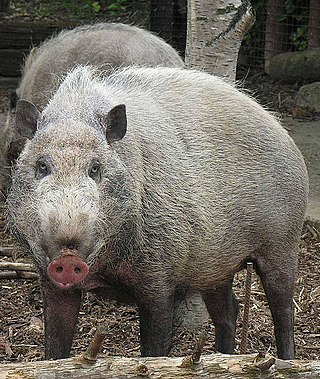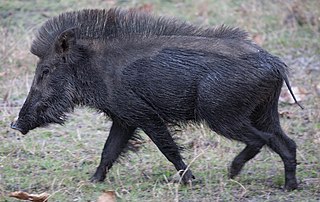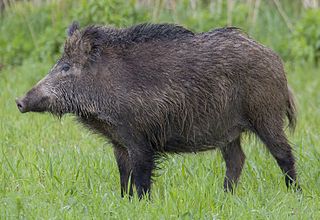
Sus is the genus of wild and domestic pigs, within the even-toed ungulate family Suidae. Sus include domestic pigs and their ancestor, the common Eurasian wild boar, along with other species. Sus species, like all suids, are native to the Eurasian and African continents, ranging from Europe to the Pacific islands. Suids other than the pig are the babirusa of Indonesia, the pygmy hog of South Asia, the warthogs of Africa, and other pig genera from Africa. The suids are a sister clade to peccaries.

The wild boar, also known as the wild swine, common wild pig, Eurasian wild pig, or simply wild pig, is a suid native to much of Eurasia and North Africa, and has been introduced to the Americas and Oceania. The species is now one of the widest-ranging mammals in the world, as well as the most widespread suiform. It has been assessed as least concern on the IUCN Red List due to its wide range, high numbers, and adaptability to a diversity of habitats. It has become an invasive species in part of its introduced range. Wild boars probably originated in Southeast Asia during the Early Pleistocene and outcompeted other suid species as they spread throughout the Old World.

Suidae is a family of artiodactyl mammals which are commonly called pigs, hogs or swine. In addition to numerous fossil species, 18 extant species are currently recognized, classified into between four and eight genera. Within this family, the genus Sus includes the domestic pig, Sus scrofa domesticus or Sus domesticus, and many species of wild pig from Europe to the Pacific. Other genera include babirusas and warthogs. All suids, or swine, are native to the Old World, ranging from Asia to Europe and Africa.

The pig, also called swine or hog, is an omnivorous, domesticated, even-toed, hoofed mammal. It is named the domestic pig when distinguishing it from other members of the genus Sus. It is considered a subspecies of Sus scrofa by some authorities, but as a distinct species by others. Pigs were domesticated in the Neolithic, both in East Asia and in the Near East. When domesticated pigs arrived in Europe, they extensively interbred with wild boar but retained their domesticated features.

The Tamworth is a British breed of domestic pig. It is the only red-coloured British pig. Its origins are unknown, but it appears to have developed near the town of Tamworth in south-eastern Staffordshire, close to Warwickshire border. It is one of seven British pig breeds listed by the Rare Breeds Survival Trust as 'priority', the highest level of concern of the trust.

The Philippine warty pig is one of four known species in the pig genus (Sus) endemic to the Philippines. They have tufts of hair on the top of their head and on the lower sides of their jaws, as well as four warts on their faces. Their skulls are elongated; males have tusks and bigger skulls than females, an example of sexual dimorphism. They are considered Vulnerable by the IUCN, and their population is currently declining due to multiple threats. The pigs are probably nocturnal.
Swine most commonly refers to the domestic pig.

Boar–pig hybrid is a hybridized offspring of a cross between the Eurasian wild boar and any domestic pig. Feral hybrids exist throughout Eurasia, the Americas, Australia, and in other places where European settlers imported wild boars to use as game animals. In many areas, a variable mixture of these hybrids and feral pigs of all-domesticated original stock have become invasive species. Their status as pest animals has reached crisis proportions in Australia, parts of Brazil, and parts of the United States, and the animals are often freely hunted in hopes of eradicating them or at least reducing them to a controllable population.
A pig is a mammal of the genus Sus.

The Palawan bearded pig is a pig species in the genus Sus endemic to the Philippines, where it occurs on the archipelago of islands formed by Balabac, Palawan, and the Calamian Islands. It is 1 to 1.6 m in length, about 1 m (3.3 ft) tall and weigh up to 150 kg (330 lb).

The banded pig also known as the Indonesian wild boar is a subspecies of wild boar native to the Thai-Malay Peninsula and many Indonesian islands, including Sumatra, Java, and the Lesser Sundas as far east as Komodo. It is known as the wild boar in Singapore. It is the most basal subspecies, having the smallest relative brain size, more primitive dentition, and unspecialised cranial structure. It is a short-faced subspecies with a white band on the muzzle, as well as sparse body hair, no underwool, a fairly long mane, and a broad reddish band extending from the muzzle to the sides of the neck. It is much smaller than the mainland S. s. cristatus subspecies, with the largest specimens on Komodo weighing only 48 kg.

The Arapawa pig is a feral breed of domestic pig found on Arapaoa Island in the Marlborough Sounds, New Zealand. Although there are suggestions that the animals are descendants of pigs introduced to the area by James Cook in 1773 and 1777, they apparently derive from Oxford Sandy and Black stock brought to the island by whalers of the Te Awaiti whaling station established in 1827 by John Guard. They are known to have inhabited the island since 1839. In 1998 four piglets were removed from the island and have since bred successfully.

The Indian boar, also known as the Moupin pig, is a subspecies of wild boar native to India, Nepal, Myanmar, western Thailand, Bangladesh and Sri Lanka.

The Japanese boar, also known as the white-moustached pig, nihon-inoshishi (ニホンイノシシ), or yama kujira, is a subspecies of wild boar native to all of Japan, apart for Hokkaido and the Ryukyu Islands.

The Central European boar is a subspecies of wild boar, currently distributed across almost all of mainland Europe, with the exception of some northern areas in both Scandinavia and European Russia and the southernmost parts of Greece. It is a medium-sized, dark to rusty-brown haired subspecies with long and relatively narrow lacrimal bones. In Northern Italy, artificially introduced S. s. scrofa have extensively interbred with the smaller sized indigenous S. s. majori populations since the 1950s.
Reuben David was a zoologist and the founder of the Kankaria Zoo in Ahmedabad, Gujarat, India.

The northern Chinese boar is a subspecies of wild boar native to China and Vietnam. The subspecies was described by Alphonse Milne-Edwards in 1871. It also occurs in Sichuan. It is likely to be the ancestor of domestic pigs.

The Anatolian boar is a subspecies of wild boar endemic to Turkey, Levant, Israel and Transcaucasia. It is likely to be one of the ancestors of today's domestic pigs.















